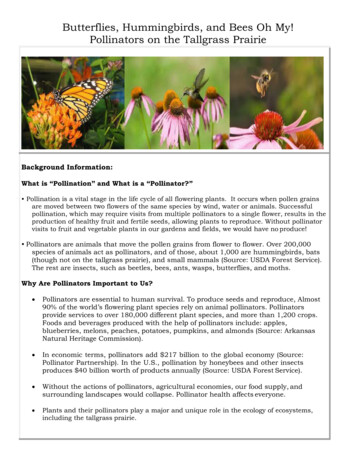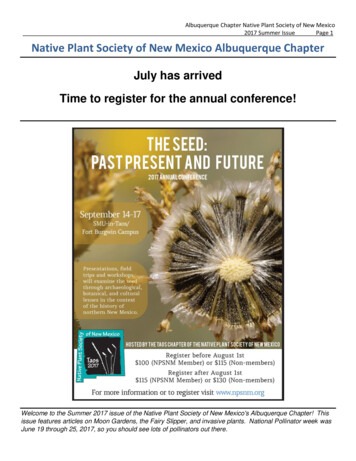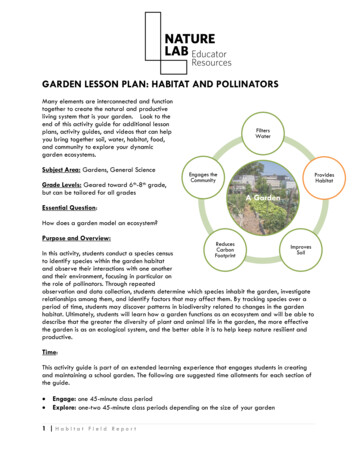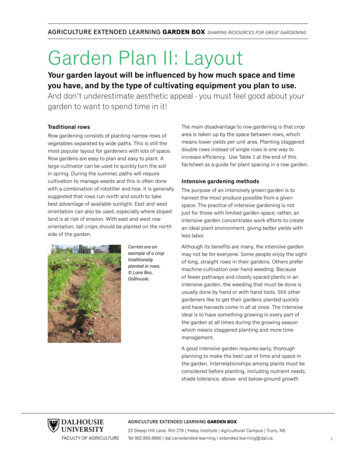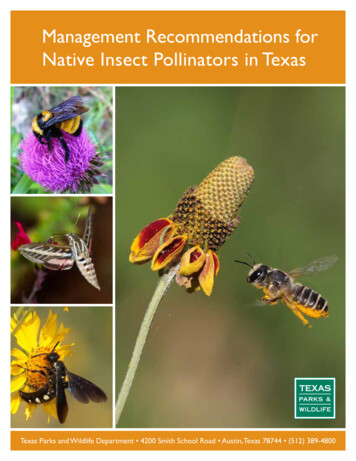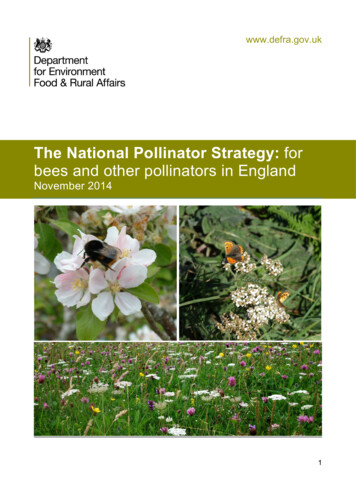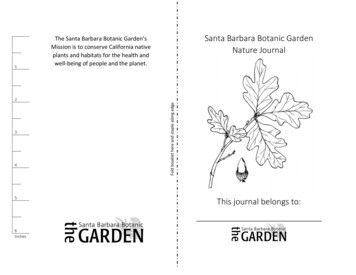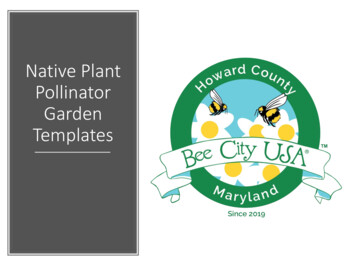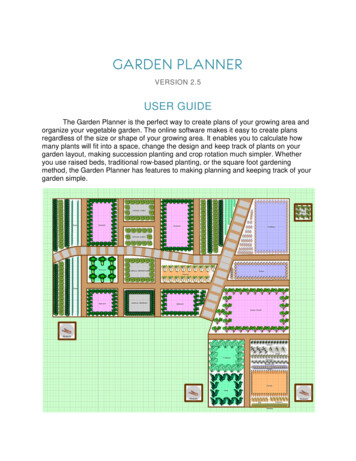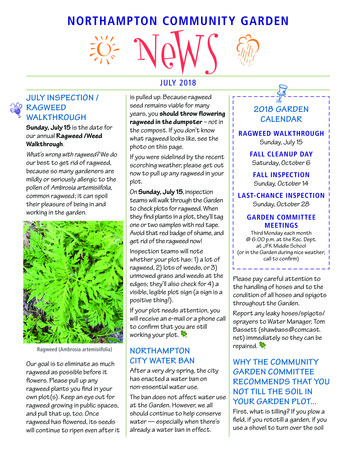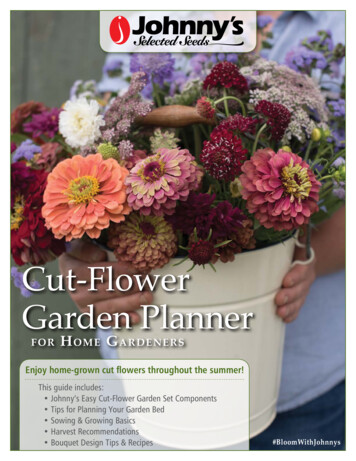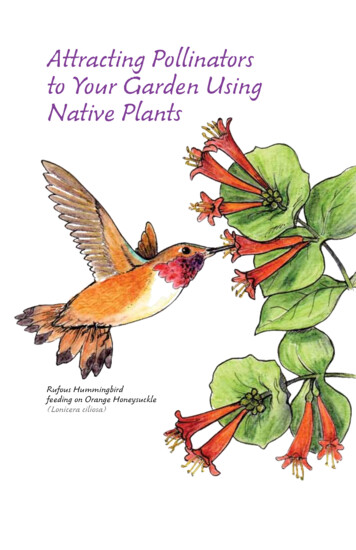
Transcription
Attracting Pollinatorsto Your Garden UsingNative PlantsRufous Hummingbirdfeeding on Orange Honeysuckle(Lonicera ciliosa)
Native Plant and PollinatorGardening GuideWhy Should We Care?Many of us enjoy the beauty of flowers in ourbackyard and community gardens. Growing nativeplants adds beauty and important habitats forwildlife, especially for pollinators. Even a smallbackyard garden can make a big difference. Gardeningconnects us to nature and helps us better understandhow nature works. This guide will help you create apollinator-friendly garden.Keystone SpeciesWhat is pollination?What dohummingbirds,butterflies andbees have incommon?They all pollinateflowering plants.Pollination is the process of moving pollen from oneflower to another of the same species, which producesfertile seeds. Almost all flowering plants need to bepollinated. Some plants are pollinated by wind or water,and some are even self-pollinating. However, mostflowering plants depend on bees,butterflies, and other animalsfor pollination.Why use native plants in your garden?Pollinators have evolved with nativeplants, which are best adapted to the localgrowing season, climate, and soils. Mostpollinators feed on specific plant species —hummingbirds sip nectar from long,tubular honeysuckle flowers, while greensweat bees prefer more open-faced sunflowers.Non-native plants may not provide pollinators withenough nectar or pollen, or may be inedible tobutterfly or moth caterpillars.When a bumble bee feeds on the nectar and pollen ofhuckleberry flowers, it pollinates the flowers, which willproduce fruit eaten by songbirds, grizzly bears, anddozens of other animals, including humans. We callthe bumble bee and other pollinators keystone speciesbecause they are species upon which others depend.Pollinators are vital to maintaining healthyecosystems. They are essential for plant reproduction,and produce genetic diversity in the plants they pollinate.The more diverse plants are, the better they can weatherchanges in the environment.Best of all, pollinators such as hummingbirds, bees,and butterflies are beautiful and fascinating.Pollinators need our help.Biologists fear several butterfly and bumble beespecies have disappeared from parts of their range,including the once common western bumble bee.Why are pollinators in trouble? It appearsthat habitat loss and pesticidepoisoning account for much ofthe population declines.We can do our part tosupport pollinators bycreating pollinatorfriendly gardens andprotecting wildlifehabitat.Insects and otheranimals pollinateone-third of thefood we eat – allkinds of fruits,vegetables, grains,nuts, and beans.Even coffee andchocolate! Theeconomic value ofinsect pollinationworldwide hasbeen estimated at 217 billion.Western Bumble Bee onMaximilian Sunflower(Helianthus maximiliani)Half-black Bumble Beeand penstemon flower12
Tongue lengthsvary in beespecies. Longtongues fit long,tubular flowerslike penstemonsand short tonguesfit short-tubedflowers likesunflowers.The EuropeanHoneybee(Apis mellifera)is a social bee.Tomatoes,peppers, andcranberries requirea special bumblebee behaviorcalled “buzzpollination”, inwhich the bumblebee grabs theflower in her jawsand vibrates herwings to dislodgepollen trappedin the flower’santhers.3Who Are Our Pollinators?Social BeesBees, butterflies, moths, hummingbirds, beetles,wasps and even flies pollinate flowers, but bee speciespollinate flowers more often than any other group,including birds and butterflies.Bumble Bee (Bombus)Busy as a BeeBees are by far the most effective pollinators becausethey feed only on flowers. Flowers attract and reward beesfor their pollination service. Bees gather two kinds of foodsfrom flowers: sugar-rich nectar to fuel their flight andprotein-rich pollen, or bee bread, to feed their young brood.Bees use their tongues to lap or lick up nectar from flowers.Bees are a diverse group of insects that include fourthousand species native to North America. They can beorganized into two groups based on their nesting lifestyle:solitary or social. About three-quarters of native bees inNorth America are solitary nest builders.Nesting LifestylesThere are forty-seven species of bumble bees inNorth America. Bumble bees are the B-1 bombers of bees.Because of their chunky size, they can fly in coolertemperatures and at lower light levels than many otherbees including the honeybee. Thus, queen bumble beesare the earliest to emerge in spring in search of the firstflowers of the season.Lifestyle: An individual queen starts a colony in the springafter she wakes from hibernation. She produces wax fromglands in her body to make pot-like cells in which to layher eggs and to store nectar and pollen for her brood.The young emerge in a few weeks as female worker bees.As fall arrives, most bees die and only newly-mated queensoverwinter to establish new colonies.PollenbasketBumble bees groompollen from theirbody hairs into“pollen baskets,”or corbicula, fortransport to thenest.GARDENINGGolden currant, serviceberry, andchokecherry flower early in March and attract bumblebees and mason bees.Half-black Bumble Bee(Bombus vagans) onRocky Mountain Bee Plant(Cleome serrulata)Solitary leaf-cutterbee (Megachile) nestSocial nestingbumble bee (Bombus)GARDENINGBees prefer blue, purple, and yellowflowers, and sweet fragrances. They see ultravioletcolors – found on the flowers such as buttercups andblack-eyed Susans.4
Green Sweat Bee(Agapostemon)Leaf-cutter Bee(Megachile)Solitary BeesSolitary BeesGreen Sweat Bee(Agapostemon)Orchard Mason Bee (Osmia lignaria)These small,brilliantlycolored, metallicgreen bees are hardto miss in a garden.They’re commonlycalled sweat bees because they land onpeople to lick up salty human sweat.Green Sweat Bee(Agapostemon)Lifestyle: Some sweat bees nest socially, on Gaillardiabut most are solitary ground-nesters.(Gaillardia aristata)A femaleLeaf-cutter Beewill cut circularleaf pieces to lineher nestingchambers.Much of what we know about the socialbehavior among insects has been learned from sweat beesbecause they show different degrees of sociality. In somespecies, females build and nest alone; in others, femalesnest communally and share a common nest entrance butconstruct individual nest cells (like apartment buildings.)These robust, metallic blue bees most commonlyappear early in spring when trees and shrubs flower.Females carry pollen on the undersides of their abdomens.Lifestyle: Orchard Mason bees build nest cells inpre-existing narrow tunnels such as beetle burrows intrees, crevices between stones, hollow centers of plantstems and abandoned wasp or bee nests. In the nesttunnel, the female builds a series of horizontal chambersprovisioning each with pollen,nectar, and an egg and thenseals the chamber with mud.By the end of summer, thebee will transform into anadult in its cocoon andoverwinter in the chamberuntil it emerges in spring.Leaf-cutter Bee (Megachile)These pugnacious bees carry pollen ontheir tummies. Leaf-cutter bees and othersolitary bees seldom sting.Leaf-cutter Bee(Megachile) onHairy GoldenAster (Chrysopsisvillosa)5Lifestyle: They construct their nestsin tunnels in the ground, understones, or in existing holesin dead wood. A femalebee cuts circular leaf piecesto line her nest chambers,which are shaped likethimbles end to end. In each,she lays an egg and provisions it withpollen and nectar for her eggs.GARDENINGGreen sweat bees and leaf-cutter beeslike composites – Erigeron, Gaillardia, sunflowers, and asters.GARDENINGImportant pollinators offruit trees, just 250 masonbees can pollinate an acreof apple trees. It would take10,000-250,000 honeybeesto do the same work.Mason bees like Penstemon,Astragalus, and nativeflowering trees such aschokecherry, hawthorn,and serviceberry.Orchard Mason Bees (Osmia lignaria)on Wilcox’s Penstemon (Penstemon Wilcoxii)Mason bee houseslike this are usedto attract theseimportant pollinators. (needcaption)Orchard Mason Bee(Osmia lignaria)If you see a beecarrying pollen onits belly or hindlegs, it’s a femalebee.6
Planning your garden –think like a pollinator.Go Native. Pollinators are“best” adapted to local, nativeplants, which often need lesswater than ornamentals.Bee Patient. It takes time for nativeplants to grow and for pollinators to findyour garden, especially if you live far fromwild lands.Bee Gentle. Most bees will avoidstinging and use that behavior only inself-defense. Male bees do not sting.Bee Bountiful. Plant bigpatches of each plant species(better foraging efficiency.)Bee Showy. Flowers should bloom in yourgarden throughout the growing season.Plant willow, currant, and Oregon grapefor spring and aster, rabbitbrush and goldenrodfor fall flowers.Bee Chemical Free.Pesticides and herbicides killpollinators.Bee Sunny.Bee Homey. Makesmall piles of branchesto attach chrysalis or cocoons.Provide hollow twigs, rotten logswith wood-boring beetle holes andbunchgrasses and leave stumps, oldrodent burrows, and fallen plantmaterial for nesting bees. Leave deador dying trees for woodpeckers.Bee Aware. ObserveBee a little messy. MostBee Diverse. Plant a diversity of flowering species withabundant pollen and nectar and specific plants for feedingbutterfly and moth caterpillars.7of our native bee species(70%) nest underground soavoid using weed cloth orheavy mulch.pollinators when you walkoutside in nature. Noticewhich flowers attractbumble bees or solitarybees, and which attractbutterflies.Provide areas withsunny, bare soil that’sdry and well-drained,preferably withsouth-facing slopes.Bee Friendly.Create pollinatorfriendly gardensboth at home, atschools and in publicparks. Help peoplelearn more aboutpollinators andnative plants.8
ButterfliesButterfliesBy growing a bounty of nativeflowering plants in your garden,you can attract a variety of themore than 220 butterflyspecies found in Montana.Two-tailed Tiger Swallowtail(Papilio multicaudata)This large butterfly (upto 6” wingspan) can befound from Maythrough August.Males can often beseen patrolling forfemales along streams,canyons and narrow roadways.Two-tailed TigerSwallowtail(Papiliomulticaudata)on WesternServiceberry(Amelanchieralnifolia), itslarval plant.Adult Silvery Blue butterflies appear from the end ofApril to September. Male butterflies can often be seenpuddling, which is sipping up soil salts and minerals inmud puddles.Lifestyle: Female blue butterflieslay eggs only on lupine and oncethey hatch, the caterpillars eatthe leaves, flowers, and seedpods.They produce a sugary secretion,or honeydew, which is eatenby ants.When disturbed, a swallowtail caterpillar rearsup and extends two red horns (osmeteria) fromits head to frighten off potential predators.Ants tend andprotect SilveryBlue caterpillars,which rewardthem withhoneydew.Silvery Blue(Glaucopsychelygdamus)Butterflies andlarva feeding onSilvery Lupine(Lupinusargenteus)Lifestyle: A good pollinator gardencontains food not just for adultbutterflies, but for their caterpillars too.Female butterflies select specific plants on which to laytheir eggs; this ensures that when their eggs hatch, thecaterpillars will be able to eat the plant’s leaves whilegrowing into adult butterflies. Two-tailed TigerSwallowtails lay their eggs on ash andchokecherry leaves.GARDENING Butterflies favor platform-shapedsunflowers and asters, but will feed on a diversity ofnectar-rich flowers from violets to serviceberry shrubs.They prefer red, purple, or yellow flowers with sweet scents.Butterflies love warm, sunny, and windless weather.9Silvery Blue (Glaucopsyche lygdamus) ButterflyGARDENINGBlue butterflies feedon nectar fromred-osier dogwood,chokecherry and other flowers.The larvae feed on lupine.10
Can you tell abutterfly froma moth?Butterflies arebrightly coloredand moths are moreoften colored inmuted grays andbrowns.A butterflyantenna (top)isa single filamentwith a club at thetip, while a mothantenna (bottom)can be broadand feathery ortapered to a point.White-linedSphinx Mothand larvae(Hyles lineata)feeding onYellow EveningPrimrose(Oenothera flava)11MothsHummingbirdsMontana may have as many as 1,800 species ofmoths. The exact number is unknown because thesenight-flying pollinators often evade detection.Because hummingbirds specialize on nectar feeding,they play an important role in pollination. Thesecolorful, migratory birds serve as a link betweenplant populations by visiting flowers andmoving pollen over great distances.White-lined Sphinx Moth (Hyles lineata)Although many moth species pollinate flowers, thesphinx or hawk moth is probably the one most familiarbecause it’s active by day.Lifestyle: They’re great flyers and some have tongueslonger than their bodies. These large moths fly upwind,tracking the airborne fragrance trail to a cluster of flowers.Their caterpillars, calledtobacco and tomatohornworms, are wellknown to gardeners.Rufous, Calliope,and Black-chinnedhummingbirdsbreed in Montana.RufousHummingbirdA tiny jewel ofa bird, the RufousHummingbird fiercelydefends its feeding areasand will attack muchlarger birds includingGreat HornedOwls.Lifestyle:RufousHummingbirds nestin willow-dominatedareas within forested habitats.GARDENING To attract hummingbirdsto your garden, provide them with nectarstarting in early spring. It’s thought thathummingbirds prefer red-colored flowers;however, they will feed on any flowerthat produces abundant nectar.Male RufousHummingbird onHoneysuckle(Lonicera ciliosa)GARDENINGSphinx moths, also called“Hummingbird” moths, prefer pale or white flowers thatopen in the evening and that have a strong, sweet smell.They pick up pollen on their legs and wings. Adults nectaron columbine and honeysuckle. Caterpillars feed onevening primrose.Sap wells created by Red-naped Sapsuckerssupply many animals with a quick energy boost.Hummingbirds need lots of insects (protein) intheir diet, and will nab insects stuck in sap wells.12
Beetles, Flies and WaspsAttract Pollinators with theseNative PlantsFlower Beetle (Typocerus)Here’s a sample of the garden-hardy native plants in ourregion that attract pollinators.Beetles present the greatest diversity of insects andpollinators. Regular flower visitors include soldier beetlesand flower beetles. They feed on pollen and even chew onflowers, but in this mess and soil pollination process theypick up pollen and carry it to other flowers.Flower Beetle(Typocerus)GARDENINGThese beetles are commonlyseen on yarrow and sunflowers.Flower or Hover Fly (Syrphid)Flower orHover Fly(Syrphid)Because they’re so abundant, flies are importantpollinators even though they transport less pollen thanbees. Hover flies mimic bees and wasps in colorationand behavior to avoid predators.GARDENING Hover flies feed on the same flowerspreferred by bees, such as golden currant, rabbitbrush,and sunflowers.Pollen Wasp (Pseudomasaris)Pollen Wasp(Pseudomasaris)Don’t be frightened if you see this wasp, it doesn’teat insects or bite humans, but seeks out flowers forpollen. A yellow-jacket look-a-like, pollen wasps can beidentified from other wasps by their clubbed antennae.They’re solitary nesters and you might find their hardmud nests attached to rocks or twigs.GARDENINGPollen wasps pollinatepenstemons and phacelias.Common NameScientific NameCommon Chokecherry. Prunus virginianaGolden Currant. Ribes aureumRed Osier Dogwood. Cornus stoloniferaBlue Elderberry. Sambucus ceruleaLewis’ Mock Orange. Philadelphus lewisiiRubber Rabbitbrush.Chrysothamnus nauseosusWestern Serviceberry. Amelanchier alnifoliaOregon Grape. Mahonia repensOrange Honeysuckle. Lonicera ciliosaBeebalm. Monarda fistulosaBluebunch Wheatgrass. Pseudoroegneria spicataBlanket Flower. Gaillardia aristataYellow Buckwheat. Erigonum flavumClarkia. Clarkia pulchellaBlue Columbine. Aquilegia coeruleaConeflower. Echinacea angustifoliaShowy Fleabane. Erigeron speciosusMissouri Goldenrod. Solidago missouriensisScarlet Globemallow. Sphaeralcea coccineaHairy False Goldenaster. Chrysopsis villosaDotted Blazing Star.Liatris punctataThreadleaf Phacelia. Phacelia linearisScarlet Gilia. Gilia aggregataMaximilian Sunflower. Helianthus maximilianiWilcox’s Penstemon. Penstemon wilcoxiiCommon Yarrow. Achillea millefolium1314
Mourning Cloak(Nymphalis antiopa)How do butterflies survive the winter?Mourning Cloak, Milbert’s Tortoiseshell, andAnglewing spend the winter as adults, butmost butterflies overwinter as eggs, caterpillarsor pupae. In your garden, tree cavities, leaflitter and branch piles shelter over-winteringbutterflies from predators and cold weather.Lolo National ForestBuilding 24, Fort MissoulaMissoula, MT 59804Text: Susan Reel Design and Illustrations: Nancy SeilerThe U.S. Department of Agriculture (USDA) prohibits discrimination in all its programs and activitieson the basis of race, color, national origin, gender, religion, age, disability, political beliefs, sexual orientation,and marital or family status. (Not all prohibited bases apply to all programs.) Persons with disabilities whorequire alternative means for communication of program information (Braille, large print, audiotape, etc.)should contact USDA’s TARGET Center at (202) 720-2600 (voice and TDD).To file a complaint of discrimination, write USDA, Director, Office of Civil Rights, Room 326-W, WhittenBuilding, 14th and Independence Avenue, SW, Washington, DC 20250-9410 or call (202) 720-5964 (voice orTDD). USDA is an equal opportunity provider and employer.Printed on recycled paper.R1-10 -5
plants to grow and for pollinators to find your garden, especially if you live far from wild lands. Bee Chemical Free. Pesticides and herbicides kill pollinators. Bee a little messy. outside in nature. Notice Most of our native bee species (70%) nest underground so avoid using weed cloth or heavy mulch. Bee Aware. Observe pollinators when you walk
